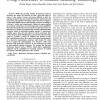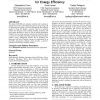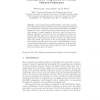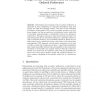972 search results - page 4 / 195 » Using Preference Order in Ontologies |
TLT
2008
13 years 7 months ago
2008
While the growing number of learning resources increases the choice for learners on how, what and when to learn, it also makes it more and more difficult to find the learning resou...
ISEMANTICS
2010
13 years 9 months ago
2010
The project SESAME uses semantic modeling and reasoning to support home owners and building managers in saving energy and in optimizing their energy costs while maintaining their ...
CONSTRAINTS
2010
13 years 5 months ago
2010
Abstract. Many computational problems linked to uncertainty and preference management can be expressed in terms of computing the marginal(s) of a combination of a collection of val...
ECAI
2004
Springer
14 years 1 months ago
2004
Springer
This paper constructs a logic of soft constraints where the set of degrees of preference forms a partially ordered set. When the partially ordered set is a distributive lattice, th...
HEURISTICS
2006
13 years 7 months ago
2006
Representing and reasoning with an agent's preferences is important in many applications of constraints formalisms. Such preferences are often only partially ordered. One clas...




